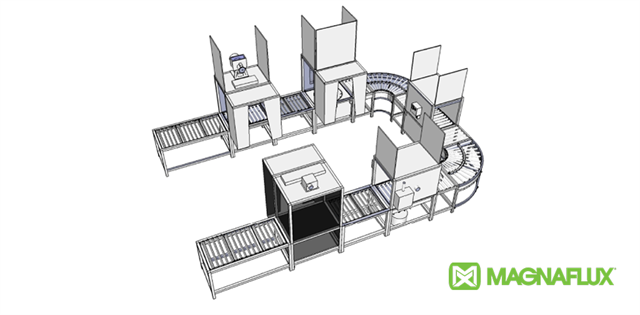By Michael Giannini, Business Development Manager
Magnaflux offers custom Liquid Penetrant Equipment to address many of our customer’s unique needs. In the past, we have taken upon large and small projects that got us to put our creative hats on in order to provide customers with smart solutions for their inspection needs. Below are two examples that highlight our commitment to tackling LPI equipment challenges.
The system shown in the drawing below is designed to process a variety of small airframe components. The outside dimensions of most components in this system are 40” X 65”, and were sized to accept the largest part that the customer would need to process. The unit includes a lowerator in the penetrant dip tank, holding tanks for clean and dirty water, a pressure pot which delivers dry developer, and a dust collector to evacuate developer from the developer station.
Parts are loaded and unloaded using customer supplied hoists, Magnaflux worked with the customer to design a special system that could fit into a limited room space.

This aerospace components manufacturer needed several cells that were built using the same processing components, but due to space constraints each cell had to be configured differently. The first system was configured in a U shape, the second was in a straight line, and the third was in an L form. In other systems we have changed the roller table length to accommodate different space requirements.
These systems use automatic spray booths to apply penetrant and include automatic spray wash stations. Both the penetrant and wash stations include mist collectors to contain fluids, and there is a collection tank for rinse water. The operating stations in these systems are 36” X 48” in dimension.
Magnaflux can custom design penetrant equipment to meet a variety of part sizes, space, and handling requirements, as well as supply monorails and overhead conveying systems as needed.
Our Engineering team loves a challenge! Call us if you want to brainstorm ideas together, or get a jump start by filling out our Penetrant Testing Equipment Checklist.


Published May 1, 2018
JOIN OUR MAILING LIST TO RECEIVE THE LATEST NDT INSIGHTS AND ARTICLES FROM MAGNAFLUX
JOIN OUR MAILING LIST TO RECEIVE THE LATEST NDT INSIGHTS AND ARTICLES FROM MAGNAFLUX
155 Harlem Avenue
Glenview, IL 60025, USA
Telephone: +1 847-657-5300
Contact Magnaflux Customer Service